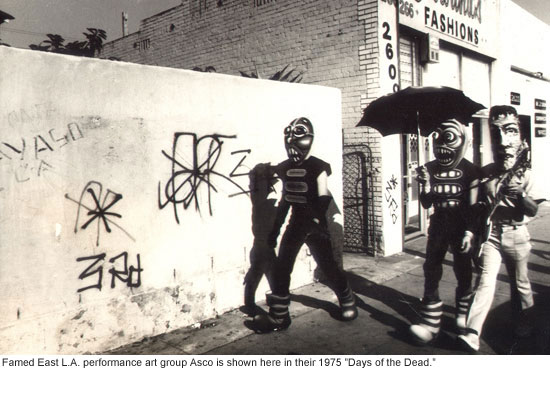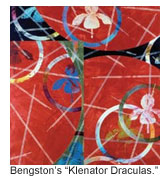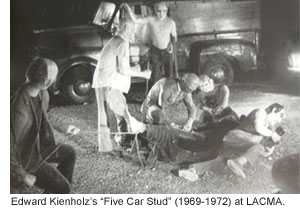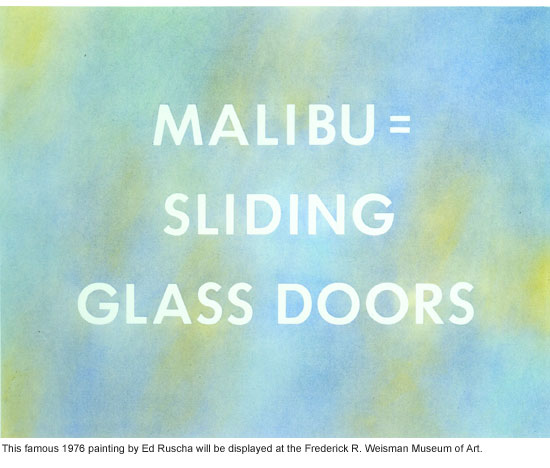Get a jump on “Pacific Standard Time”
August 31, 2011
 It’s going to be a big, big autumn for art in Los Angeles. In fact, a few places are already offering a sneak peak at the season’s most massive undertaking—“Pacific Standard Time.”
It’s going to be a big, big autumn for art in Los Angeles. In fact, a few places are already offering a sneak peak at the season’s most massive undertaking—“Pacific Standard Time.”
More than 60 cultural institutions and 60 galleries across Southern California will be joining forces in coming weeks to jointly tell the story of L.A.’s rise on the post-World War II art scene. The collaboration—its full name is “Pacific Standard Time: Art in L.A. 1945-1980”—will offer an unprecedented panorama of West Coast art and design.
The initiative was launched about ten years ago after local curators and artists became concerned that important L.A. work was not being appropriately preserved and archived.
“Many of the key figures were getting up in years, [and] their papers were being dispersed,” says Andrew Perchuk, deputy director of the Getty Research Institute. With nearly $10 million in grants from the Getty Foundation, a plan was launched to not only recapture an era, but also share its back story.
What emerged was the mother of all group shows.
“Initially, we thought there would be four or five related exhibitions, but then it just started snowballing,” says Rani Singh, co-curator of the Getty Center’s own exhibition, “Pacific Standard Time: Crosscurrents in LA Painting and Sculpture, 1950-1970,” which opens October 1.
That’s the official kickoff date for the “Pacific Standard Time” extravaganza, whose highpoints will include exhibitions featuring such greats as Ed Ruscha, Lita Albuquerque, Betye Saar, Henry Takemoto, David Hockney and Judy Chicago, as well as the first major study of California midcentury modern design.
Unofficially, however, dozens of exhibitions are scheduled to open early, with several key shows welcoming the public as soon as this week.
Among them: the first public showing in the United States of Edward Kienholz’s “Five Car Stud (1969-72),” and the first retrospective of the work of the legendary East L.A. underground arts collective, Asco.
Both of those exhibitions open Sunday, September 4, at the Los Angeles County Museum of Art, under the Pacific Standard Time banner. But LACMA is just one of many places offering a first taste of L.A.’s incoming autumn of art.
Here’s an early “Pacific Standard Time” sampler for this weekend:
- “California Art: Selections from the Frederick R. Weisman Art Foundation” has been open
 since August 27 at the Frederick R. Weisman Museum of Art near the Malibu campus of Pepperdine University. Weisman was an early patron and friend of L.A. artists and his collection features such now-renowned names as Ed Ruscha and Robert Irwin. The show features pieces by those artists and others whose work went on to become almost synonymous with art in L.A .
since August 27 at the Frederick R. Weisman Museum of Art near the Malibu campus of Pepperdine University. Weisman was an early patron and friend of L.A. artists and his collection features such now-renowned names as Ed Ruscha and Robert Irwin. The show features pieces by those artists and others whose work went on to become almost synonymous with art in L.A .
- “It Happened at Pomona: Art at the Edge of Los Angeles, 1969-1973, Part 1: Hal Glicksman at Pomona.” This show, at the Claremont liberal arts college that produced Chris Burden, has been open since August 30 at the Pomona College Museum of Art. Glicksman was a pioneering curator during the late 1960s and early 1970s, and his guidance shaped a generation of L.A. artists. The first of three “Pacific Standard Time” exhibitions at the museum, the Glicksman show features such important artists as Judy Chicago, Michael Asher and Lewis Baltz.
- Edward Kienholz’s “Five Car Stud (1969–72)” was among the artist’s last works in Los Angeles before he left to live between Idaho and
 Berlin. It remains one of his most disturbing pieces to this day. A devastating tableau in a darkened room around a dirt patch, it depicts a black man being pinned down in a circle of headlights and castrated by white attackers while a white woman vomits in his pickup. Acquired by a Japanese collector shortly after a its only public showing (in Europe), it remained in storage until 2007, when it was sent for restoration to Kienholz’ widow, artist Nancy Reddin Kienholz. Its September 4 opening at LACMA, 17 years after Kienholz’ death, will mark the piece’s American public debut.
Berlin. It remains one of his most disturbing pieces to this day. A devastating tableau in a darkened room around a dirt patch, it depicts a black man being pinned down in a circle of headlights and castrated by white attackers while a white woman vomits in his pickup. Acquired by a Japanese collector shortly after a its only public showing (in Europe), it remained in storage until 2007, when it was sent for restoration to Kienholz’ widow, artist Nancy Reddin Kienholz. Its September 4 opening at LACMA, 17 years after Kienholz’ death, will mark the piece’s American public debut.
- “Asco: Elite of the Obscure, A Retrospective, 1972–1987 “ is the first retrospective of a L.A.’s seminal 1970s Chicano arts collective, now individually famous as Gronk, Harry Gamboa, Jr., Willie Herrón and Patssi Valdez. Inspired by influences that ranged from the Chicano rights movement to Dada, the four spent several years inciting happenings and doing performance art on the streets of East L.A., making themselves legendary in the city’s avant-garde underground long before anyone heard of guerrilla art or flash mobs. (Click here for a video of the L.A. artist Gronk recalling Asco’s style and history.) Today, a generation of young L.A. artists credit them as an influence.
- “Maria Nordman, Filmroom: Smoke, 1967–Present” is also opening September 4 at LACMA. Light—particularly the light in L.A.—is one of the great recurring themes in the “Pacific Standard Time” shows. Nordman began making her light-filled films and installations in the mid-1960s; this film was made in 1967 without a script on a beach in Malibu. It features two actors, but the sun and the Pacific Ocean are co-stars, the artist has said.
Posted 8/31/11















 405 bridge work causes a stink
405 bridge work causes a stink